
PORTUGAL
THIS year, Portugal celebrates the fifth centenary of the publication of the first book in Portuguese; Macau celebrates the fourth centenary of the first book printed with movable type. Before the first book to be printed in Portuguese, the Tratado de Confissom printed in Chaves in 1489, the Pentateuch had already been printed in Hebrew in Faro in 1487 at Samuel Gacon's press.
In 1965, a certain Dr. Miguel Quina bought the Tratado de Confissom from Tarcísio da Trindade, an antiquarian bookseller. He sold it in 1987 for $50,000 to the Portuguese Ministry of Culture which bought it for the National Library.
However, the Brazilian bibliographer Rosemarie Erika Horch maintains that this was not the first book to be published in Portuguese, claiming that on the 18th of April, 1488, another book had been printed in Chaves, a translation of the Sacramental by Clemente Sanchez. It was presented to the National Library in Rio de Janeiro in 1889 or 1890 where it remains to this day.
GOA
GOA was the first Eastern city to have a European printing press. It was taken there by the Jesuits and the first book to come off the press was the Conclusões. The Jesuit Brother João Bustamente who arrived in Goa on the 3rd of September, 1556, was the first printer. The Conclusões came off the press a month later.
On the 30th of April, 1556, the Jesuit Father Gaspar Calaça had written from Lisbon to the Society in Rome, saying that the Patriarch D. João Nunes Barreto, Father João de Mesquita and Father Gualdames and three Jesuit brothers, one of whom was the printer Bustamente, had set off for Ethiopia: "... and on this visit made by the Patriarch and all the others, the King gave them an Indian, a very able printer, to help Brother Bustamente with the press he took from here".
So it was that an Indian from Goa was Brother Bustamente's first assistant in the press which the Jesuits established in Goa in 1556. (1)
The Conclusões was composed of two parts, the first dealing with logic by Brother Francisco Cabral and the second dealing with Philosophy by Brother Manuel Teixeira who was later to come to Macau in 1565 as one of the three Jesuits who founded the Society's first Residence in the city.
The press arrived at Goa two hundred and twenty two years before going to Calcutta, proving that the Portuguese were the real pioneers of the period.
It was the Patriarch of Ethiopia, D. João Nunes Barreto, who was responsible for taking the press to Goa, but the man who brought the press from Goa to Macau was the Jesuit Father Alexander Valignano.
ALEXANDER VALIGNANO
THE famous Alexander Valignano (1539-1606) was born into a noble family in Chieti, Italy. He gained his doctorate in Civil Law from the University of Padua at the age of eighteen. After a spell at the papal court of Paul IV in the service of Cardinal Altemps, he entered the Society of Jesus on the 27th of May, 1556 at the age of twenty seven.
Father Everardo Mercuriano, General of the Society (1573-1580), appointed him Father-Visitor for the Jesuit Missions from the Indias to Japan in August, 1573. He set sail from Lisbon on the ship Chagas on the 21st of March, 1574 with a group of twenty one Portuguese, Spanish and Italian Jesuits. They anchored in Goa on the 6th of September of the same year. He travelled through all of India from 1575 to 1577 and towards the end of April, 1578, he set off for Macau where he arrived in September.
At that time, Macau had ten thousand inhabitants and was a peninsula linked to China by the Porta do Cerco.
Father Alexander's intention was to open China to the word of God. Father Álvaro Semedo recounts that on opening the window of his room and looking towards the Chinese continent he exclaimed: "Rock, oh Rock, when shall you finally open up to the Evangelist?". (2)
He set off for Japan on the 7th of July, 1579, arriving on the 25th of the same month. Once there, he organized the first diplomatic mission from Japan to Europe (1582-1591) which arrived in Macau on the 9th of March, 1582 and left again on the 31st of December of the same year. From October 1583 until October 1587 he served as the Superior of the East Indies. But he had again been appointed Father-Visitor at the beginning of 1587 and so he arrived in Macau from Goa on the 28th of July, 1588, bringing the printing press with him. On the 23rd of June he was off on his travels once more, visiting Japan as Ambassador to the Viceroy of India. The 24th of October, 1592, saw him back in Macau where he remained until sailing to Goa on the 16th of November, 1594. He arrived in Goa on the 4th of March, 1595. Back in Macau in July, 1597, he set sail the following year for Japan staying there until January of 1603. In February, he returned to Macau where he remained until his death in the city on the 20th of January, 1606. (3)
PRINTING IN MACAU
ON the 1st of December, 1578, Father Valignano wrote from Macau to the Archbishop of Évora, D. Teodósio de Bragança: "I have ordered type which I shall take with me to Japan to print the books which have been inspected and expurgated and are found to be suitable for Japan". (4)The type he ordered consisted of European letters. Valignano had not gone to Europe with the Mission as was planned. Instead, as he had been appointed Superior of the East Indies in October, 1583, and was forced to stay in Goa. The Mission arrived in Goa on the 29th of May, 1587 on its way back from Europe. Father Valignano embarked on the same ship as the ambassadors, taking with him the press. They arrived at Malacca seventy days later, rested for twelve days and then set off for Macau where they arrived on the 28th of July, 1588.
Valignano had intended going on to Japan as Ambassador to the Vice-roy of India, but as the Shogun was unwilling to receive missionaries he had to wait in Macau for one and a half years before setting off. During this time, however, the press did not lie idle.
In 1588 there was a reprint of a book which had already been published in Salamanca in 1575 and re-edited in Burgos. The book was entitled Christiani Pueri Institutio, Adolescentiaque Perfugium: auctores Ioanne Bonifacio Societatis Iesu. cum libri unius, & rerũ accessione plurimarũ: Cum facultate Superiorum: Apud Sina, in Portu Macaensi: in Domo Societatis Iesu: Anno 1588. The book consisted of 252 pages and there is only one remaining copy in the world, that in the Library of the Ajuda Palace in Lisbon. (5)
Nevertheless, the first European publication in China dates from 1585 for, in early January, 1586, Valignano sent a copy of an Abecedário Latino to the General of the Society. This was probably an alphabet for the use of the Japanese with a list of Chinese characters, most probably the two hundred and fourteen radicals.
Prior to the 8th of October, 1589, Senazario Emmendado was published according to Father Lourenço Mexia, SJ. This was possibly a collection of poems by Iacopo Sannazzaro. (6)
Father Bernard mentions another two books printed on the Jesuits' press in Macau: a grammar book in 1588 and Mateus Ricci's Diálogo in 1590. (7)
The first book to be published in Macau by Europeans appeared in 1585 before Father Valignano's press had arrived. It is a catechism in Chinese by Father Miguel Ruggieri, SJ, called O Verdadeiro Conjhecimento de Deus. The cover features an oval with the words of the Psalmist "A Solis Ortusque Ad Occasum Laudabile Nomen Domini Ps: CXIIT". In the centre of the oval there is the emblem of the Society of Jesus: IHS. (8)
In Nos Pontos Que Me Alembra, Father Francisco Pires, SJ, writes the following about Ruggieri: He then printed a catechism which a Christian scholar here wrote for him in Chinese. The scholar was hoping to obtain a degree but, God willing (and perhaps to make him a Christian) this was denied him and when his wife hanged herself in despair he left home in shame, meeting the Father on the road, who received him with kindness.
He worked as a Teacher for some years. The Father ordered a Catechism to be printed in Chinese which was then distributed all over China and brought many to meet the Father when he went with the Portuguese to Canton. (9).
Two copies of this Chinese catechism were sent to Rome, one of them printed on silk. Apparently two other copies were sent to the Jesuit Archives in Rome. (10)
Quoting Ricci, José Maria Braga adds: "Father Ruggieri also devoted himself to compiling a Latin-Chinese Vocabulary, the first edition of which was printed in Macau in 1585 under the direction of Father Valignano ". (11)
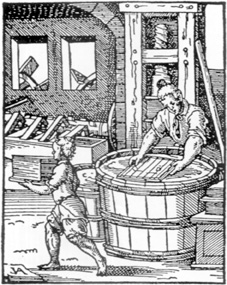 Paper-making (XVIth century German engraving). There were paper mills functioning in Portugal from at least 1411. As in the rest of Europe, ground cereals were used in paper mills to satisfy the demand for writing material, given the scarcity of parchment.
Paper-making (XVIth century German engraving). There were paper mills functioning in Portugal from at least 1411. As in the rest of Europe, ground cereals were used in paper mills to satisfy the demand for writing material, given the scarcity of parchment.
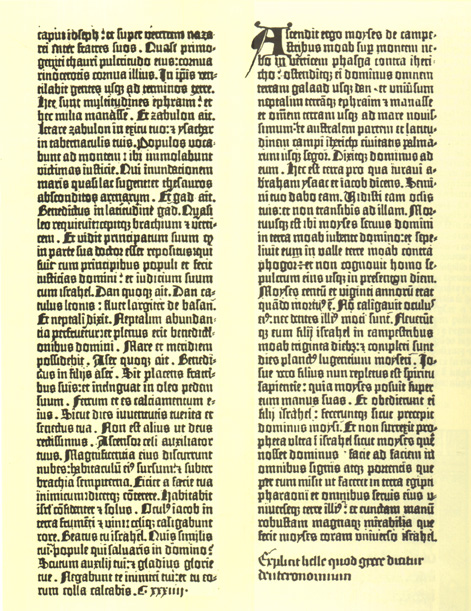 Page from the 42 line Bible printed by Gutenberg which marked the dawn of printing in Europe.
Page from the 42 line Bible printed by Gutenberg which marked the dawn of printing in Europe.
In 1590, the following work was printed in Macau: De Missione Iaponensium ad Romanam curiam, rebusq; in Europa, ac toto itinere animadversis. Dialogus ex ephemeride ipsorum legatorum colectus; & in sermonem latinum versus ab Eduardo de Sande Sacerdote Societatis IESU. In Macaensi portu Sinici regni in domo Societatis IESU cum Facultate Ordinarii, & Superiorum. Anno 1590., in other words "Report on the Japanese Mission to Rome and the things they saw in Europe and along their journey, compiled from the diaries of the members of the Mission and translated into Latin by Duarte de Sande, a priest in the Society of Jesus. (12)Printed in Macau in the Kingdom of China in the Jesuit Residence under licence from the Ordinary and the Superior Officials in the year 1590".
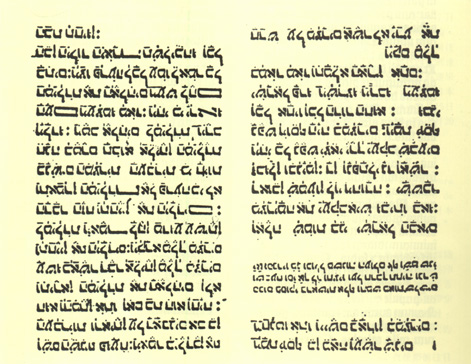
Page from the Pentateuch (Faro, Samuel Gacon, 1487) - the first book to be printed in Portugal.
The priest responsible for getting the book to the press was D. Leonardo de Sá who did so on the 3rd of September, 1589. The book was also censored and approved of by Fathers Valignano, Tiago Antes and Nicolau de Ávila on the 4th of October, 1589. We can thus assume that the book went to the press in 1589 and appeared in 1590.
The original, most probably in Spanish, was written by Valignano and the Latin translation was by Sande. Sande comments in the preface that the book would be translated into Japanese and Father Daniele Bartoli, SJ, says that one thousand copies of the Japanese version were distributed in Japan.
The Latin original was reprinted in 1593 in Anvers with the title "De Trium Regum Japonicorum Legatis" (Concerning the Three Ambassadors of the Japanese Kings).
In 1862, António José de Figueirado published a summarized Portuguese version called "The First Japanese Embassy to Visit Europe" in the“Arquivo Pitoresco” Vol. V. This was reprinted in Macau in 1961 with preface and notes by Father Benjamim Videira Pires and José Maria Braga. (13)
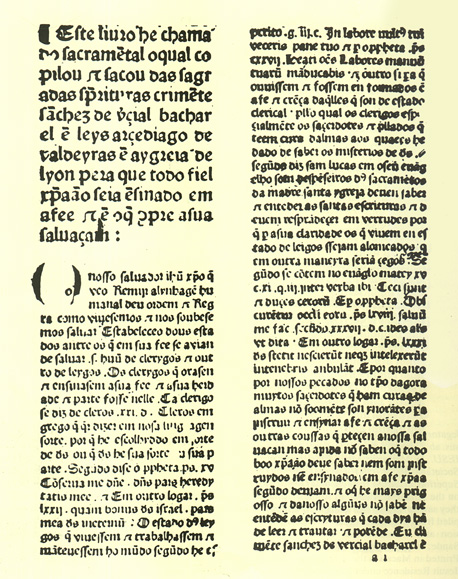
"Incipit" from the Sacramental by Clemente Sanchez de Vercial in the incunabular Portuguese translation (1488?) now held by the National Library in Rio de Janeiro. This is said to be the first book printed in the vernacular in Portugal although the date and press are not known.
Valignano left Macau for Japan on the 23rd of June, 1590, taking with him the ambassadors and the press. They arrived in Nagasaki on the 21st of July and Valignano sent the press to Katsusa where it began work as early as October. In 1592, Valignano went to Amakusa and then some years later to Nagasaki, returning finally to Macau where he died in 1606.
In 1591 Sanctos no Gosagayo-no Uchi Nukigaki (Lives of the Apostles, Saints and Martyrs) was printed in Katsusa.
Father Johannes Laures published a catalogue of more than thirty works produced on this press and mentions a further twenty five. Of the thirty, three were printed in Macau and the rest in Japan. (14) One of the most significant books to come off the press was the Vocabulário da Lingoa de Iapam by Father João Rodrigues printed in 1603 in Nagasaki, and in the following year Arte da Lingoa de Iapam, also printed in Nagasaki.
In 1620, Arte Breve da Lingoa Iapoa tirada da Arte Grande da Mesma Lingoa, pera os que começom a aprender os primeiros princípios della... Em Amacao no Collegio da Madre de Deos da Companhia de IESV. Anno MDCXX. was published in Macau. However, only one hundred copies of the work were printed.
With reference to this work, Father Michael Cooper, SJ, writes: "It is regretful, if not in fact shameful, that João Rodrigues the Interpreter has still not been properly recognised in the West".(15)
According to Father Gomes Rodelles, SJ, the Jesuits sold the printing press to the Augustinian Order in Manila, but Father Schilling of the same order has his doubts about this. (16)What cannot be denied, however, is the profound and lasting influence the arrival of Valignano's press in Macau and Japan had in the subsequent histories of these two oriental countries.
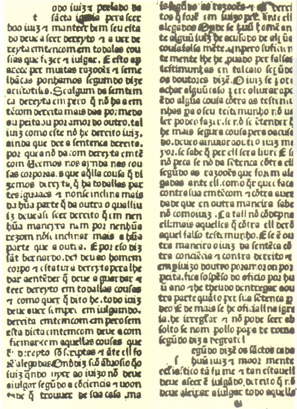
Opening page of the Tratado de Confissom (Chaves, printer unknown, 1489) - the first book to be printed in Portuguese with a definite date.
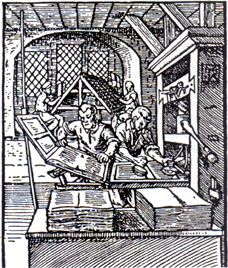
Type-shop from the early days of printing (German engraving published in a book by Jost Ammann in 1568).
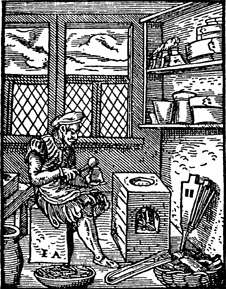
Casting type-letters (engraving by Jost Ammann).
NOTES
(1)For more on printing in Goa see António Garcia: "O IV Centenário da Imprensa de Goa" in Brotéria, October, 1956, pp. 268-276; Amândio Gracias: Os Portugueses e o Estabelecimento da Imprensa na Índia, p. 1938.
(2) Álvaro Semedo: Histoire Universelle de la Chine, Lyon, 1667, p.253.
(3) For more on Valignano see Don Ferrante: Vita del Padre Alessandro Valignano, Rome, 1698; "The Panegyric of Alexander Valignano”, Monumenta Nipponica, V, Tokyo, 1942, pp. 523-635; D'Elia: I Grandi Missionari, II, Rome, 1940, pp. 119-170; Joseph Dehergne, SJ: Réportoire des Jésuites de Chine de 1552 à 1800, Rome, 1973.
(4)Jordão de Freitas: A Imprensa de Tipos Móveis em Macau e no Japão nos Fins do Séc. XVI, in "Anais das Bibliotecas e Arquivos de Portugal", Coimbra, 1915, vol. I, n o5, p.211 on.
(5)Father Johannes Laures, in the Second Supplement to Kirishitan Bunko, Tokyo, 1951, p.4 says that Father Humertclaude claims a copy of this book is mentioned in M. Augusti Beyeri Memoriale Historico-Crítico Librorum Rariorum, Dresde et Lipsiae, apud Fredericum Hekel, 1734, p.106; see Jack Braga Primórdios da Imprensa em Macau, Macau, 1965, p.12, note 11.
(6)Pasquale D'Elia, SJ, Fonti Ricciane, I, pp.223-3; Father Joseph Schütte, SJ, Christliche Japanische Literatur, Bilder und Druckblatter in einem Unbekannten Vatikanischen Codex ans dem Jahre 1591, in "Archivum Historicum Sociaetatis Jesu", vol. IX, fasc. 2, Rome, 1940, p.271. Jacopo Sannazaro was born in Naples in 1458, the son of a Spanish family. He was a great poet who wrote in Italian and Latin and his work was praised by Pope Clement VII. His life was spent either involved in amorous activities or writing poetry. His poetry combined the sacred with the profane: he described the Virgin Mary as "The hope of the Gods" and portrayed her as reading Greek verse rather than the Psalms of David.
He died at the age of 72 in 1530 and was buried in the chapel of one of his country houses. His mausoleum was decorated with statues of Apollo and Minerva but the names of David and Judith were later inscribed below them to remedy this profanation.
It was hardly surprising that the Jesuits had to expurgate his poems before printing them in Macau.
(7)Father Henri Bernard: Le Père Mathieu Ricci et la Societé Chinoise de son Temps, (1552-1610), Tientsin, 1937, p. 115.
(8)Jack Maria Braga: Primórdios da Imprensa em Macau, p.21.
(9)Ib., p. 10, note 8.
(10)Ib., p.10, note 8.
(11)Ib., p.10.
(12)Father Joseph Schütte, SJ, proved that it was in fact Valignano who wrote De Missione Legatorum Japonensium in Latin. Father Sande merely touched up Valignano's Latin (Shütte: Analecta Gregoriana, vol. 70, 1954). Duarte de Sande was born in Guimarães in 1545. He joined the Society of Jesus at the age of fifteen in 1562 and set sail for India on the S. Luís on the 24th of March, 1578, as Superior. He was rector in Bassain but left Goa for Macau in May, 1585. From 1585 to 1597, he was Superior of the China Mission founded by Ricci in 1583. Duarte de Sande was a fine Latin scholar. He died in Macau at the end of July, 1599.
(13)A lot has been written about this first Japanese Mission to Europe: Alfons Kleiser in Monumenta Nipponica, I (Tokyo, 1938); Henri Bernard, ib., p.378-385; Abranches Pinto, Yoshitono Ukamoto et Maitre Henri Bernard, La Première Ambassade du Japon en Europe, Première Partie (1582-1586), Tokyo, 1942; Georg Schurhammer, SJ, "Die Ersten Japonische Gesandtshaftreiseise nach Europe (1582-1590)" in Katholischen Missionen, vol. 49, 1920-21; see also Duarte de Sande ob. cit.
(14)Father Johannes Laures: Kirishitan Bunko - A Manual of Books and Documents on the Early Christian Missions in Japan, Tokyo, 1949.
(15)Michael Cooper, SJ: Rodrigues the Interpreter, New York, Toyko,1974, p.238.
(16)See Jack Maria Braga, ob. cit. p.16, note 18.
Translated from the Portuguese by Marie Imelda Macleod
*Internationally renowned historian, specialist in the History of Macau, and the Portuguese and the Church in the Orient, Father Teixeira is the author of over one hundred and fifteen books. He is a member of the Portuguese Academy of History and several international organisations and institutions.
start p. 3
end p.